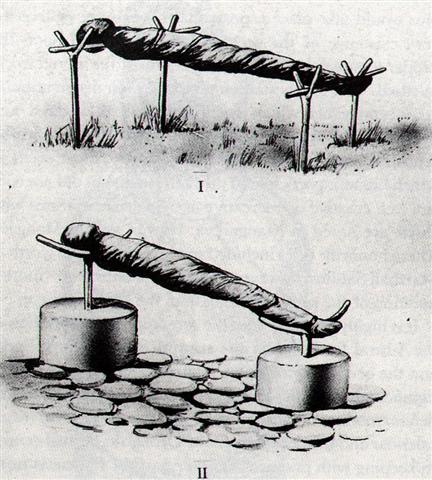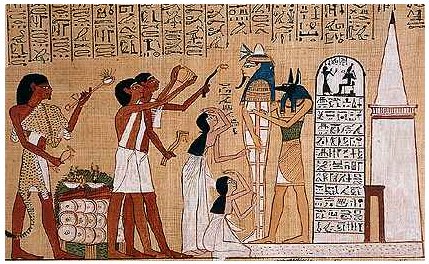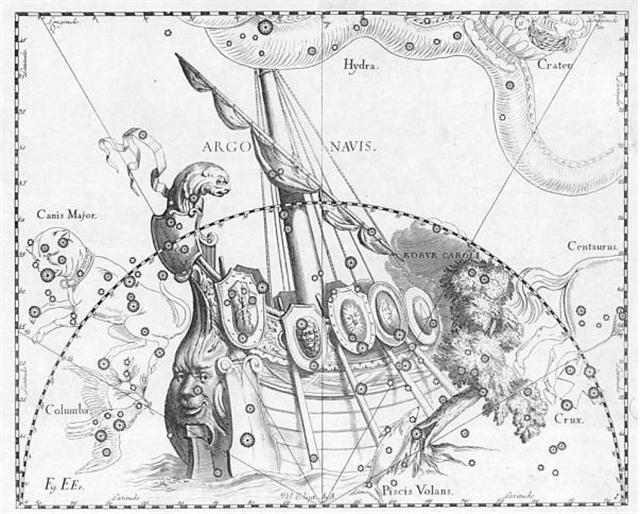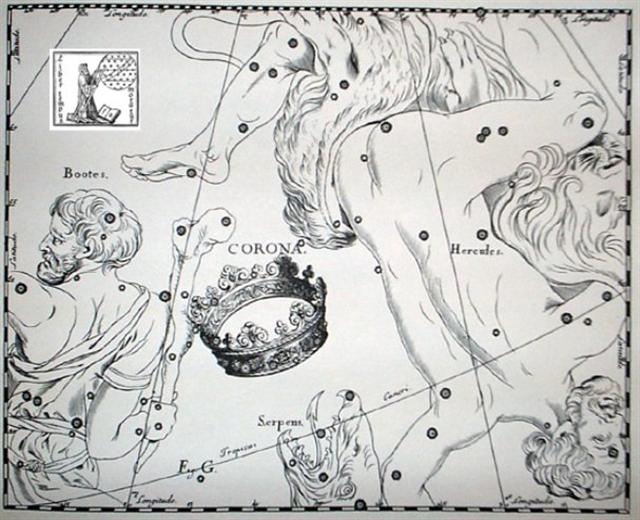Clearly it is reasonable to read the stars
heliacally here:
|
*APRIL 13 |
14 |
15
(*25) |
16 |
17
(107) |
 |
 |
 |
 |
 |
|
Ga1-27 |
Ga1-28 |
Ga1-29 |
Ga1-30 |
Ga2-1 |
|
6h
(91.3)
ν
Orionis (91.4), θ Columbae (91.5), π Columbae
(91.6) |
ξ
Orionis (92.5) |
Al
Han'ah-4 /
Maru-sha-pu-u-mash-mashu-7
(Front of the Mouth of the Twins)
TEJAT PRIOR
= η
Gemini (93.4), γ Monocerotis (93.5), κ Aurigae
(93.6), κ Columbae (93.8) |
FURUD
= ζ Canis Majoris
(94.9) |
Well-22 (Tapir) /
Arkū-sha-pu-u-mash-mashu-8 (Back of the
Mouth of the Twins)
δ
Columbae (95.2),
TEJAT POSTERIOR
= μ
Gemini,
MIRZAM (Announcer)
= β
Canis Majoris (95.4),
CANOPUS = α Carinae
(95.6), ε Monocerotis (95.7), ψ1 Aurigae (95.9) |
|
June
20 (171) |
SOLSTICE |
22 |
23 |
ST
JOHN'S DAY |
|
NAKSHATRA DATES: |
|
*OCTOBER 13 |
14 |
15
(288) |
16 |
17
(*210) |
|
ZHŌNGSHĀN = ο
Herculis (274.0), π Pavonis (274.6) |
ι Pavonis (275.1),
POLIS = μ
Sagittarii (275.9)
MENKAR
(α Ceti)
|
η Sagittarii (276.9) |
Purva Ashadha-20 |
|
KAUS MEDIUS = δ
Sagittarii, κ Lyrae (277.5),
TUNG HAE (Heavenly Eastern
Sea) = η Serpentis (277.7),
SHAOU PIH (Minor Minister)
= φ Draconis (277.8), KWEI
SHE = χ Draconis (277.9) |
φ Oct. (278.1),
KAUS AUSTRALIS = ε Sagittarii (278.3), ξ
Pavonis (278.4), AL
ATHFAR (Talons of the Falling Eagle) = μ
Lyrae (278.6) |
|
December 20 (354) |
SOLSTICE |
22 |
23 |
CHRISTMAS EVE |
|
*APRIL 18 (108) |
19 |
20 |
21 |
22 (*32) |
23 |
24 |
 |
 |
 |
 |
 |
 |
 |
|
Ga2-2 (32) |
Ga2-3 |
Ga2-4 |
Ga2-5 |
Ga2-6 |
Ga2-7 |
Ga2-8 |
|
no star listed (96) |
β Monocerotis, ν Gemini (97.0) |
no star listed (98) |
ν Puppis (99.2), ψ3 Aurigae (99.4), ψ2
Aurigae (99.5)
GEMMA (α Cor. Bor.)
|
ψ4 Aurigae (100.5),
MEBSUTA (Outstretched)
= ε Gemini (100.7) |
SIRIUS = α Canis Majoris
(101.2), ψ5 Aurigae (101.4), ψ6 Aurigae
(101.7) |
τ Puppis (102.2), ψ7 Aurigae (102.4) |
|
June 25 |
(6 * 29½ = 177) |
27 |
28 |
29 |
30 |
July 1 |
|
NAKSHATRA DATES: |
|
*OCTOBER 8 |
9 |
10 |
11 (*214) |
12 |
13 |
14 |
|
KAUS BOREALIS =
λ Sagittarii (279.3) |
ν Pavonis
(280.4), κ Cor. Austr. (280.9) |
Abhijit-22 θ Cor.
Austr. (281.0),
VEGA = α Lyrae
(281.8) |
no star listed
(282) |
ζ Pavonis
(283.4), λ Cor. Austr. (283.6),
DOUBLE DOUBLE =
ε Lyrae (283.7), ζ Lyrae (283.8) |
South Dipper-8
(Unicorn)
Φ Sagittarii
(284.0),
μ Cor. Austr. (284.6), η Cor. Austr., θ
Pavonis (284.8) |
SHELIAK (Tortoise)
= β Lyrae, ν Lyrae (285.1), ο
Draconis (285.5). λ Pavonis (285.7)
ATLAS (27 Tauri)
|
|
December 25 |
26 (360) |
27 |
28 |
29 |
30 |
31 |
North of the equator this was not toga
but a more inviting season:

|
 |
|
toga |
toga-hora |
|
Toga
1. Winter season. Two seasons
used to be distinguished in ancient times:
hora, summer, and toga, winter. 2. To
lean against somehing; to hold something fast;
support, post supporting the roof. 3. To throw
something with a sudden movement. 4. To feed
oneself, to eat enough; e-toga koe ana oho ki
te aga, eat well first when you go to work.
Vanaga. 1. Winter. P Pau., Mgv.: toga,
south. Mq.: tuatoka, east wind. Ta.:
toa, south. 2. Column, prop; togatoga,
prop, stay. Togariki, northeast wind.
Churchill.
Wooden platform for a dead
chief: ka tuu i te toga (Bb8-42), when
the wooden platform has been erected. Barthel 2.
The expressions Tonga, Kona,
Toa (Sam., Haw., Tah.), to indicate the
quarter of an island or of the wind, between the
south and west, and Tokelau, Toerau,
Koolau (Sam., Haw., Tah.), to indicate
the opposite directions from north to east -
expressions universal throughout Polynesia, and
but little modified by subsequent local
circumstances - point strongly to a former
habitat in lands where the regular monsoons
prevailed. Etymologically 'Tonga', 'Kona',
contracted from 'To-anga' or 'Ko-ana',
signifies 'the setting', seil. of the sun. 'Toke-lau',
of which the other forms are merely dialectical
variations, signifies 'the cold, chilly sea'.
Fornander. |
| Hora
Ancient name of summer (toga-hora,
winter summer). Vanaga. 1. In haste (horahorau).
2. Summer, April; hora nui, March;
vaha hora, spring. 3. 'Hour', 'watch'. 4.
Pau.: hora, salted, briny. Ta.:
horahora, bitter. Mq.: hoáhoá, id. 5.
Ta.: hora, Tephrosia piscatoria, to
poison fish therewith. Ha.: hola, to
poison fish. Churchill.
Horahora,
to spread, unfold, extend, to heave to;
hohora, to come into leaf. P Pau.: hohora,
to unfold, to unroll; horahora, to spread
out, to unwrap. Mgv.: hohora, to spread
out clothes as a carpet; mahora, to
stretch out (from the smallest extension to the
greatest), Mq.: hohoá, to display, to
spread out, to unroll. Ta.: hohora, to
open, to display; hora, to extend the
hand in giving it. Churchill. |
| Horau
1. In haste, on the point of;
horau hitihiti, daybreak; horau mai,
to run to, to bring, to appear; horau marama
no iti, daybreak. Horauhorau,
immeditely, sooner, forthwith; active, diligent,
fecund, generous, unexpected, sudden, pressing,
prompt, rapid, swift, speedy, all at once; to go
boldly, to appear suddenly, to be precipitate,
to press on, to grow rapidly; haga horhorau,
to slight; tae horahorau, to be arrested
in growth. Horahoraukina, agile.
Horauhorau, brief, to continue. Horarau,
to run. (P Pau.: horo, to flee, to run.
Mq.: hoó, to go quickly, prompt, brisk,
to run, to make haste. Ta.: horo, to run;
horohoro, activity, quickly. The
conduplication horahorau militates
against this identification.) 2. Pau.: horau,
a shed. Ta.: farau, id. Sa.: afolau,
a common house. Ma.: wharau, shed.
Churchill. |
The Full Moon was at the Victorious
station:
|
SAGITTARIUS: |
|
20 |
Purva Ashadha |
δ and ε Sagittarii |
Elephant tusk, fan, winnowing basket |
278 = 259
+ 19 |
|
first of the ashādhā (the
invincible one, the name of a constellation) |
Kaus |
Dec 24 (358) |
|
LYRA: |
|
22 |
Abhijit |
α, ε, and ζ Lyrae |
- |
281 = 278
+ 3 |
|
victorious |
Vega |
Dec 27 (361) |
|
SAGITTARIUS: |
|
21 |
Uttara Ashadha |
ζ and σ Sagittarii |
Elephant tusk, small bed |
288 = 281
+ 7 |
|
second
of the ashādhā |
Nunki |
Jan 3 (368) |
I.e., it was the month when north of
the equator the Old Oak (Jupiter) was sacrificed,
because the Sun would here reach Gemini.
It was in the dead of winter (toga) on Easter
Island.

...
Midsummer is the flowering season of the oak, which
is the tree of endurance and triumph, and like the
ash is said to 'court the lightning flash'. Its
roots are believed to extend as deep underground as
its branches rise in the air - Virgil mentions this
- which makes it emblematic of a god whose law runs
both in Heaven and in the Underworld ... The month,
which takes its name from Juppiter the oak-god,
begins on June 10th and ends of July 7th. Midway
comes St. John's Day, June 24th, the day on which
the oak-king was sacrificially burned alive. The
Celtic year was divided into two halves with the
second half beginning in July, apparently after a
seven-day wake, or funeral feast, in the oak-king's
honour ...
Toga-hora of the new year evidently
ran from
day 108 according to the
time when Hyadum II had risen heliacally at 0h. And
the month name could have been Toki.
|
Toki
Small basalt axe. Vanaga.
Stone adze. Van Tilburg. Ha'amoe ra'a
toki = 'Put the adze to sleep' (i.e.
hide it in the temple during the night).
Barthel. Month of the ancient Rapanui
calendar. Fedorova according to Fischer.
To'i. T. Stone adze
(e to'i purepure = with the
wounderful adze). Henry. The Araukan Indians
in the coastal area of northern Chile, have
customs similar to those on the Marquesas
and in both areas toki means adze
according to José Imbelloni. The Araukans
also called their chief of war toki
and the ceremonial adze symbolized his
function and was exhibited at the outbreak
of war. In Polynesia Toki was the
name of a chief elevated by the Gods and his
sign was the blade of a toki. Fraser.
Axe, stone hatchet, stone
tool ...; maea toki, hard slates,
black, red, and gray, used for axes T. P
Pau.: toki, to strike, the edge of
tools, an iron hatchet. Mgv.: toki,
an adze. Mq.: toki, axe, hatchet.
Ta.: toi, axe. Churchill. |
| ... The adze is shown
in ancient Egypt from the Old Kingdom
onward. Originally the adze blades were
made of stone, but already in the
Predynastic Period copper adzes had all
but replaced those made of flint. While
stone blades were fastened to the wooden
handle by tying, metal blades had
sockets into which the handle was
fitted. A
depiction of an adze was also used as a
hieroglyph, representing the consonants
stp, 'chosen', and used as: ...
Pharaoh XX, chosen of God/Goddess YY...
The ahnetjer
(Manuel de Codage transliteration:
aH-nTr) depicted as an adze-like
instrument, was used in the Opening of
the Mouth ceremony, intended to convey
power over their senses to statues and
mummies. It was apparently the foreleg
of a freshly sacrificed bull or cow with
which the mouth was touched ...
The ritual involved
the symbolic animation of a statue or
mummy by magically opening its mouth so
that it could breathe and speak. There
is evidence of this ritual from the Old
Kingdom to the Roman Period. Special
tools were used to perform the ceremony,
such as a ritual adze, an arm shaped
ritual censer, a spooned blade known as
a peseshkaf, a serpent-head
blade, and a variety of other amulets. A
calf's leg was also held up to the lips
painted on the coffin.

The ancient Egyptians
believed that in order for a person's
soul to survive in the afterlife it
would need to have food and water. A
special ritual called the 'Opening of
the Mouth' was performed so that the
person who died could eat and drink
again in the afterlife ... |
The Toki month could have
ended 8 weeks from the beginning of the text, i.e.
with day 120 counted from 0h. From ζ Canis Majoris
(Furud) to Naos (ζ Puppis) - from the first Rei
in the text
to the 2nd (significantly at 2-27 alluding to
π = 22 / 7) - there
were 201 - 175 = 26 days:
|
*MAY 10 |
11 |
12 |
13 (*53) |
14 |
15 |
 |
 |
 |
 |
 |
 |
|
Ga2-24 |
Ga2-25 |
Ga2-26 (56) |
Ga2-27 |
Ga2-28 |
Ga2-29 |
|
φ Gemini
(118.4) |
DRUS
= χ Carinae (119.9) |
ω Cancri
(120.2) |
8h (121.7)
χ Gemini
(121.0),
NAOS
= ζ Puppis
(121.3) |
ρ Puppis (122.0),
HEAP OF FUEL = μ Cancri
(122.1), ζ Monocerotis
(122.3), ψ Cancri (122.6),
REGOR = γ Velorum
(122.7) |
TEGMINE
(Covered Up)
= ζ Cancri
(123.3) |
|
July 17 |
18 |
19 (200) |
20 (*121) |
21 |
22 |
|
NAKSHATRA DATES: |
|
*NOVEMBER 9 |
10 (314) |
11 |
12 |
13 |
14 |
|
ι Sagittarii (301.2),
TEREBELLUM = ω Sagittarii,
ξ Aquilae (301.3),
ALSHAIN = β Aquilae
(301.6),
φ Aquilae
(301.8) |
ε Pavonis, θ Sagittarii
(302.3), γ Sagittae (302.5),
μ Pavonis (302.7) |
τ Aquilae
(303.8) |
20h (304.4)
η Sagittae (304.2), δ
Pavonis (304.4) |
SHANG WEI (Higher Guard) = κ
Cephei
(305.2), θ Sagittae (305.4),
TSEEN FOO (Heavenly
Raft) = θ Aquilae (Ant.)
(305.6), ξ Capricorni
(305.8) |
TSO KE (Left Flag) = ρ
Aquilae
(306.3) |
|
January 16 |
17 |
18 (383) |
19 |
20 |
21 |

The great star at the
starboard steering oar was Canopus.
And the star at
the nose of the old Lion in the
stern was
ν Puppis. When the Sun
reached that star it meant Gemma (α Corona Borealis)
was culminating in the night:
|
*APRIL 18 |
19 (*29) |
20 |
21 (111) |
22 |
23 |
24 |
 |
 |
 |
 |
 |
 |
 |
|
Ga2-2 |
Ga2-3 (33) |
Ga2-4 |
Ga2-5 |
Ga2-6 |
Ga2-7 |
Ga2-8 |
|
no star listed (96) |
β Monocerotis, ν Gemini
(97.0) |
no star listed (98) |
ν Puppis
(99.2), ψ3 Aurigae
(99.4), ψ2 Aurigae
(99.5)
GEMMA (α Cor. Bor.)
|
ψ4 Aurigae (100.5),
MEBSUTA (Outstretched)
= ε Gemini (100.7) |
SIRIUS = α Canis Majoris
(101.2), ψ5 Aurigae
(101.4), ψ6 Aurigae
(101.7) |
τ Puppis (102.2), ψ7
Aurigae (102.4) |
|
June 25 |
(6 * 29½ = 177) |
27 |
28 |
29 |
30 |
July 1 |
|
NAKSHATRA DATES: |
|
*OCTOBER 8 |
9 |
10 |
11 (*214) |
12 |
13 |
14 |
|
KAUS BOREALIS = λ
Sagittarii (279.3) |
ν Pavonis (280.4), κ
Cor. Austr. (280.9) |
Abhijit-22
θ Cor. Austr. (281.0),
VEGA = α Lyrae
(281.8) |
no star listed (282) |
ζ Pavonis (283.4), λ
Cor. Austr. (283.6),
DOUBLE DOUBLE = ε
Lyrae (283.7), ζ Lyrae
(283.8) |
South Dipper-8
(Unicorn)
Φ Sagittarii
(284.0), μ Cor. Austr.
(284.6), η Cor. Austr.,
θ Pavonis (284.8) |
SHELIAK (Tortoise)
= β Lyrae, ν
Lyrae (285.1), ο
Draconis (285.5). λ
Pavonis (285.7)
ATLAS (27 Tauri)
|
|
December 25 |
26 (360) |
27 |
28 |
29 |
30 |
31 |
... In other words, the ancient
Druidic religion based on the
oak-cult will be swept away by
Christianity and the door - the
god Llyr - will languish
forgotten in the Castle of
Arianrhod, the Corona
Borealis ...

|
Egyptian cobra in
repose |
 |
Phoenician nūn |
 |
Greek
nu |
Ν (ν) |
|
...
Nun is
thought to have come
from a pictogram of
a snake (the Hebrew
word for snake,
nachash begins
with a Nun
and snake in Aramaic
is nun) or
eel.
Some
have hypothesized a
hieroglyph of a fish
in water for its
origin (in Arabic,
nūn means
large fish or
whale). The
Phoenician letter
was named
nūn 'fish',
but the glyph has
been suggested to
descend from a
hypothetical
Proto-Canaanite
nahš
'snake', based on
the name in
Ethiopic, ultimately
from a hieroglyph
representing a
snake.
... Nahš
in modern Arabic
literally means 'bad
luck'. The cognate
letter in Ge'ez and
descended Semitic
languages of
Ethiopia is nehas,
which also means
'brass'. |
|














